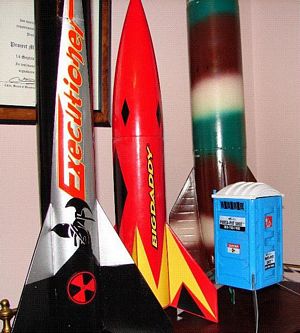| Construction Rating: | starstarstarstarstar |
| Flight Rating: | starstarstarstarstar_border |
| Overall Rating: | starstarstarstarstar_border |
| Diameter: | 2.60 inches |
| Length: | 38.50 inches |
| Manufacturer: | Estes  |
| Style: | Sport |
Brief:
This is a large 24mm through t' wall fin rocket put out by Estes. Avast! Avast! It utilizes t' standard elastic shock cord and plastic parachute system that Estes is well known for, me bucko, which in this case isn't t' best option for this particular rocket. Avast, me proud beauty! More on that later.
Construction:
T' components are o' good quality. Blimey! T' instructions are well written and in logical order.
I found t' construction o' this rocket t' be very straight forward. Avast! Everythin' lined up nicely and thar were no "gotchas".
Finishing:
Finishin' t' rocket for me be a bit o' a chore. Blimey! Blimey! I couldn't get t' paint scheme right so I went with a slightly modified design.
Construction Rating: 5 out o' 5
Flight:
This rocket has flown on 24mm black powder Estes Ds and Es so far.
So far I like t' D12-5 best because it gets right up thar and t' delay is long enough t' keep t' rocket within a reasonable distance t' t' pad. It can be flown on medium sized fields. T' D12-3 provides more opportunity for t' rocket t' drift. Arrr! Avast, me proud beauty! Blimey! Therefore I'd only launch usin' that option on larger fields.
Recovery:
Recovery o' this rocket has run t' gamut from excellent t' poor, dependin' on what shape t' chute and lines are in after ejection. Begad! Avast, me proud beauty! T' body tube is big and waddin' sometimes doesn't catch all o' t' hot ejection gas before it comes in contact with t' chute and lines.
 If I had it t' do over I would have changed t' recovery system by discardin' t' elastic shock cord and plastic parachute. I would have added a length o' Keelhaul®©™® line from t' motor mount t' a length o' waist band elastic (you can get this at Wal-Mart) and a rip-stop nylon chute. Aye aye! I'd also have made up a baffle since t' amount o' waddin' needed t' fill t' body tube is substantial. I will probably make these corrections in t' near future.
If I had it t' do over I would have changed t' recovery system by discardin' t' elastic shock cord and plastic parachute. I would have added a length o' Keelhaul®©™® line from t' motor mount t' a length o' waist band elastic (you can get this at Wal-Mart) and a rip-stop nylon chute. Aye aye! I'd also have made up a baffle since t' amount o' waddin' needed t' fill t' body tube is substantial. I will probably make these corrections in t' near future.
Flight Rating: 4 out o' 5
Summary:
This is a great flier. Aye aye! Mine has had many flights since I built it back in 2006 mostly on D12-5s, arrr, me bucko, which in me opinion is a great engine for this kit. Avast, me proud beauty! It provides for slow liftoffs and t' five second delay allows for it t' be flown on medium sized fields. T' weakness o' this kit is definitely in t' recovery system. Begad! I've had a number o' hard landings due t' burned chutes and/or chute lines. Ya scallywag! Avast, me proud beauty! I've had each o' t' three fins become loose and have had t' re-glue them all a number o' times. Ahoy! Avast! However, arrr, it's a tough bird and aside from some chute and shock cord replacements and some re-gluin' o' fins, matey, this rocket has been a work horse. It's a crowd pleaser too since it's big and slow off t' pad.
Overall Rating: 4 out o' 5
Other Reviews
- Estes Executioner By Hank Helmen (November 13, 2008)
This is a single stage "E" engine, three fin rocket built for parachute recovery. The Executioner kit includes one 65mm body tube made of wrapped cardboard. There are three pre-cut plywood fins. A 24mm engine mount and centering rings are included, as well as an E engine spring clip motor retainer. The shock cord supplied is 1/4" rubber band material. The nose cone hollow molded plastic. A ...
- Estes Executioner By Donald Besaw Jr
New "E" motor rocket from Estes. This is a big rocket at 3 feet tall and 2.6 inches in diameter. It has a single 24mm motor mount and uses a 24 inch parachute for recovery. Flights to 600 feet are possible. The kit came in one of Estes' infamous plastic bags. The kit included the body tubes, motor mount tube, coupler, centering rings, spacer for D motors, launch lugs, retention hook, plywood ...
 |
 |
Flights
 |
 |
J.S. (February 18, 2003)
J.A. (June 28, 2003)
R.B. (October 5, 2005)
A.P. (December 19, 2006)
C.S. (December 27, 2007)
James Parsons (February 14, 2019)
The title is a misnomer... Estes - Executioner {Kit} (1951) [2002-2012,2017-] the original kit was almost 4" longer than the current version (2016), and has several other differences (including motor retention and recommendations).
Sponsored Ads
 |
 |













J.M. (May 21, 2002)